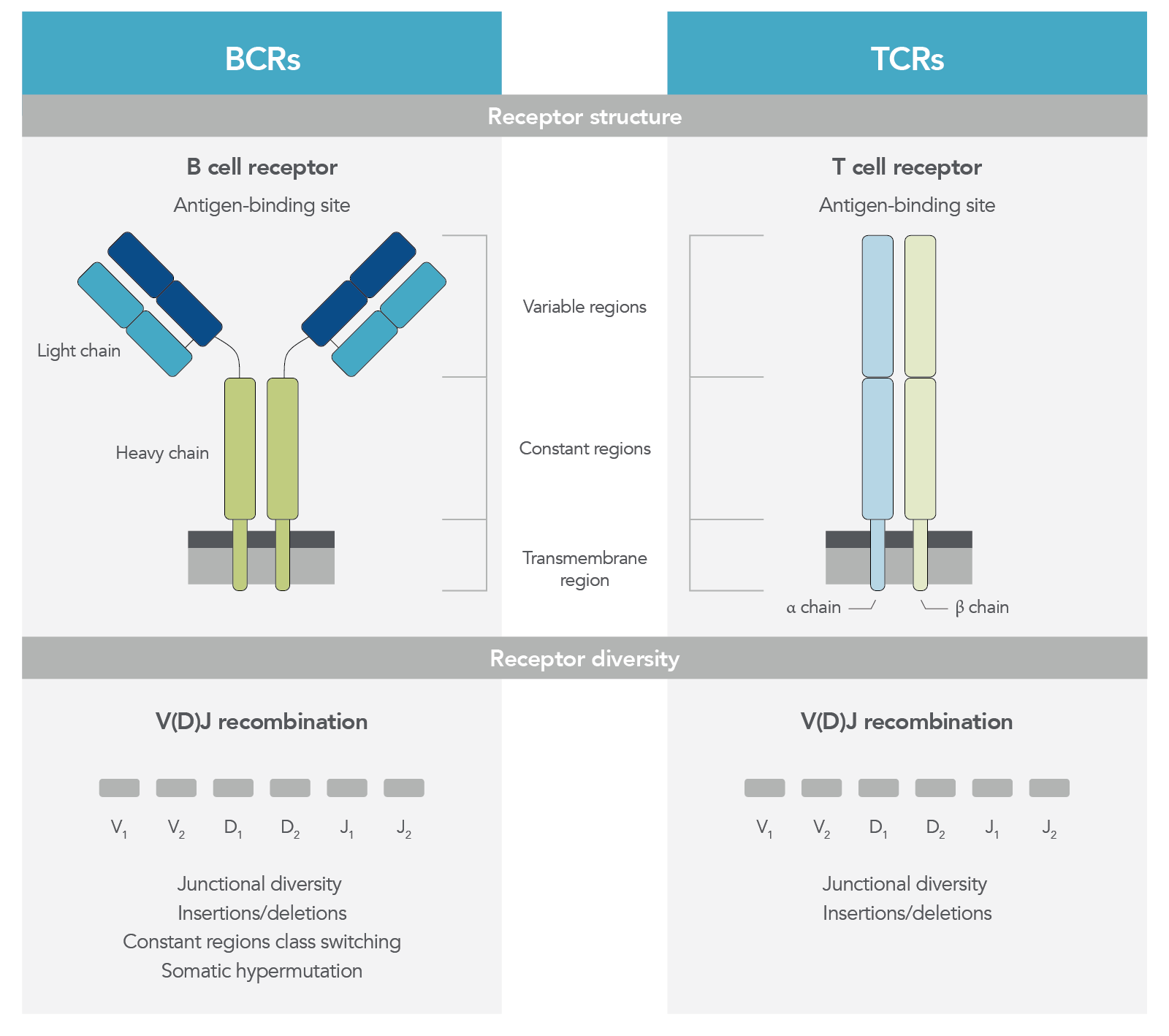Immune profiling research assays
Comprehensive profiling of cancers — including the immune repertoire — can provide valuable insights to oncology researchers. T- and B-cell clonalities, MRD determination, tumor infiltrating lymphocyte quantification, and somatic hypermutation analysis are important for characterizing cancers. Learn about these biomarkers and how Archer NGS assay solutions can help.
Archer™ NGS assay solutions
Overview
Immune profiling is important for understanding cancers
The adaptive immune system plays a vital role in cancer biology. Several areas of profiling the immune repertoire have demonstrated value in oncology research, including T- and B-cell clonalities, MRD determination, tumor infiltrating lymphocyte quantification, and somatic hypermutation analysis.
Unique T and B-cell receptors (TCRs and BCRs) are generated via the process of V(D)J somatic recombination to create a diverse array of sequences in B and T cells (Figure 1). Interrogating BCRs and TCRs via NGS provides insights into potentially malignant clones. While TCRs are comprised of alpha, beta, gamma, and delta chains, B-cell receptors are comprised of heavy and light chains (Figure 1). These unique genomic sequences are fingerprints of T or B-cell clonotypes and can be used to track MRD in lymphoid malignancy research.
Tumor infiltrating lymphocytes (TILs) are an important biomarker in several solid tumors, including lung, breast, colon, melanoma, sarcoma, and gliomas. Their presence and quantification can be helpful to understand tumor behavior. For example, the quantification of TILs in breast cancer has led to the definition of lymphocyte-predominant breast cancer (50-60% TILs), which is associated with tumor senescence [1].
Somatic hypermutation analysis has been a valuable biomarker in B-cell lymphoma. Immunoglobulin heavy chain (IGH) gene rearrangements acquire somatic hypermutations upon exposure to an antigen, which is a normal development in B-cells. Researchers have found that the somatic hypermutation status of a malignant B-cell clone is a useful biomarker to stratify disease states in chronic lymphocytic leukemia (CLL). It has been demonstrated that CLL populations with high somatic hypermutation (often referred to as “mutated”) have less aggressive behavior [2], while more aggressive disease is associated with B-cell tumors without somatic hypermutation. BCR constant region class switching is an additional area of oncology research.
Figure 1. B-cell receptor and T-cell receptor structure and diversity. V(D)J recombination in B-cell and T-cell receptor genomic loci allows for a huge diversity of BCR and TCR sequences. This variety enables B and T-cell recognition of novel pathogens and neoantigens.
Gain immune profile insights with IMMUNOVerse Assays
Next generation sequencing of T- and B-cell receptor regions enables labs to perform critical research on the interplay between the adaptive immune system and oncology. IMMUNOVerse TCR and BCR panels are targeted RNA assays that assess clonality, MRD, TILs, and somatic hypermutation, each of which are active areas in oncology research. For example, one research study used the IMMUNOVerse TCR panel to assess the value of TILs as a biomarker in BRCA1/2 tumors using FFPE from prostate cancer samples[3].
IMMUNOVerse assays are based on Anchored Multiplex Chemistry™ (AMP) and Archer Analysis, which include several features useful in these application areas. AMP chemistry is designed to amplify effectively, even through hypervariable sequencings and variable length fragments. This enables rare clone detection, even with potentially degraded FFPE tissue. Archer Analysis corrects for amplification bias and sequencing errors to provide a true and reproducible measure of clonotypes, which is useful for MRD and somatic hypermutation detection.
Pairing IMMUNOVerse panels with FUSIONPlex™ and VARIANTPlex™ assays can provide a clearer understanding of cancers. Specifically pairing FUSIONPlex and IMMUNOVerse can allow researchers to answer questions about the interplay between biomarkers and tumor progression. For example, labs may use a FUSIONPlex panel to investigate translocations in a blood cancer sample and pair this information with data from an IMMUNOVerse panel to fingerprint the malignant clonotype.
IMMUNOVerse assays provide information on TCR and BCR RNA, whose expression levels may change in response to antigens. Therefore the assays are a useful tool for research on autoimmune disorders, infectious disease, and antigen‑immune response.
Immune Profiling Research Assays
Immune Profiling Panels
Related Blood Cancer Panels
Related Solid Tumor Panels
Ready to start?
Learn how IMMUNOVerse panels can identify key genomic alterations for your research.
Request a consultationResources
References
- Aftimos P, Azim Jr. HA, Sotiriou C. Molecular Biology of Breast Cancer. In: Coleman WB, Tsongalis GJ (editors). Molecular Pathology. Academic Press. 2018; 569-588.
- Dunn-Walters D, Thiede C, Alpen B, Spencer J. Somatic hypermutation and B-cell lymphoma. Philos Trans R Soc Lond B Biol Sci. 2001;356(1405):73-82.
- Jenzer M, Keß P, Nientiedt C, et al. The BRCA2 mutation status shapes the immune phenotype of prostate cancer. Cancer Immunol Immunother. 2019;68(10):1621-1633.


